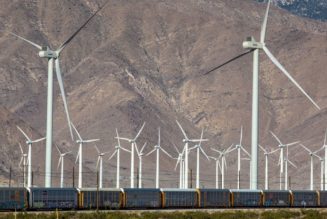This year, the clean energy sector finally started grappling in earnest with one of its biggest challenges: how to get enough minerals to build solar panels, wind turbines, and big batteries for electric vehicles and energy storage. Figuring that out will be critical for escaping fossil-fueled ecological disaster. It’ll also be crucial for policymakers and industry to move forward without throwing certain communities under the bus in the transition to clean energy.
Instead of cutting through landscapes with oil and gas wells and pipelines, clean energy industries and their suppliers will open up the Earth to hunt for critical minerals like lithium, cobalt, and copper. Compared to a gas-fired power plant, an onshore wind turbine requires nine times more mineral resources, according to the International Energy Agency. Building an EV requires six times more minerals than a gas-powered car.
It’s about time to scrutinize what that hunger for minerals might cause, given the recent boom in pledges from countries and companies alike to reach net zero greenhouse gas emissions. Digging up the necessary minerals is already proving to be a minefield. Protests are popping up at proposed mines that no one really wants in their backyard. The conflicts that cropped up in 2021 are just the beginning of a challenging road ahead.
In May, the International Energy Agency (IEA) issued a warning: the world isn’t mining enough of the minerals that are the building blocks of a clean energy future. And supply chains for many critical minerals are vulnerable, according to the IEA’s report. “Left unaddressed, these potential vulnerabilities could make global progress towards a clean energy future slower and more costly – and therefore hamper international efforts to tackle climate change,” Fatih Birol, executive director of the IEA, said in a statement at the time. “This is what energy security looks like in the 21st century.”
The cobalt used in EV batteries, for example, mostly comes from the Democratic Republic of Congo. A majority of the world’s rare earth minerals, used in EV motors and wind turbines, are produced and processed in China. So if anything rattles production in those countries, the whole world might feel the effects. On top of that, the concentration of power over vital resources in specific countries and companies creates the potential for environmental and human rights abuses, which have plagued supply chains for cobalt and rare earth minerals. Investigations into cobalt mines that are essential suppliers to the EV battery industry have already found widespread labor abuses.
To make things harder, the COVID-19 pandemic has put even more pressure on clean energy supply chains. Rising shipping and commodity prices could delay or even cancel solar projects slated for 2022, according to research firm Rystad Energy. Soaring metal prices could slow down the entire transition to renewable energy throughout the decade, says the International Monetary Fund.
Regardless, Joe Biden has committed the US to halving its emissions from peak levels this decade. Longer term, he’s pushing for a clean-energy grid by 2035 and net zero emissions by 2050. In order to reach those goals, the US will need large quantities of minerals, which is why the Biden administration has made securing them a priority since stepping into office this year. By June, Biden had announced a “whole-of-government” effort to shore up domestic supply chains, with a big focus on critical minerals and advanced batteries used for renewable energy and electric vehicles. As the administration sees it, domestic supply chains can help the US wean itself off dirty fossil fuels, while also minimizing its reliance on mining in other countries — especially where labor abuses are a big problem.
:no_upscale()/cdn.vox-cdn.com/uploads/chorus_asset/file/23132148/481583360.jpg)
But even in the US, clean energy-related mining can come with costs, and it’s already looking like Native Americans and other marginalized groups might bear a disproportionate burden of those costs. One high-profile tussle is building up at Nevada’s Thacker Pass, the site of the largest lithium resource in the country. If a proposed lithium mine moves forward, it will dig up a potential gravesite that’s sacred to members of the Fort McDermitt Paiute and Shoshone Tribes and other local tribes. Residents are also worried about how the mine might harm wildlife and use up water in a state suffering a historic drought. The Nez Perce Tribe in Idaho faces the prospect of a new mining project tearing up their landscape to produce gold, a key ingredient for many electronics, and antimony, that could be used in futuristic batteries. Then there’s the proposed copper mine at Oak Flat in Arizona that would desecrate lands sacred to members of the San Carlos Apache Nation and other Indigenous peoples in the region. Copper is widely used across the grid and for solar and wind energy technologies.
Around the world, the race is on to find new sources of the minerals needed for clean energy. Mining companies are now eyeing patches of the seafloor that contain polymetallic nodules rich in cobalt, rare earth elements, and other metals. While companies argue that mining the seafloor is one way to avoid polluting communities near land-based mines, their eagerness to bring heavy industry to a largely unexplored environment has alarmed hundreds of marine scientists, who published a statement in September saying such activity could irreparably hurt deep-sea ecosystems. Despite their concerns, the International Seabed Authority (ISA), which oversees activities on the high seas, is seemingly poised to push through new rules that could open up the world’s oceans for deep sea-mining after convening earlier this month.
There are ways to get the minerals the clean energy revolution needs while minimizing the impact on people and the planet. Startups are figuring out how to get better at recycling lithium batteries. Joe Biden campaigned on a promise to create millions of clean energy jobs while defending workers’ right to unionize, which might offer workers in US mines more protections. Tribes are entitled to “free, prior, and informed consent” to any project that might affect them or their territories, under the United Nations Declaration on the Rights of Indigenous Peoples. We can also boost energy efficiency, use more public transit, and consume less.
As renewable energy starts to outpace fossil fuels, it will need to avoid the ways coal, oil, and gas bulldozed through communities at great costs to people and the environment. And if decision-makers can chart a path for a just transition to renewable energy, they might be able to heal more than the damage our demand for energy has inflicted on the climate.









